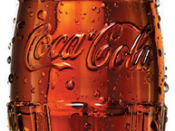Stephen Brennan
Accounting II
Tue/Thur. 3-4:30
The Wall Street Journal recently did an article on how the soft-drink battleground has now turned
toward new overseas markets. While once the United States, Australia, Japan, and Western
Europe were the dominant soft-drink markets, the growth has slowed down dramatically, but they
are still important markets for Coca-Cola and Pepsi. However, Eastern Europe, Mexico, China,
Saudi Arabia, and India have become the new 'hot spots.' Both Coca-Cola and Pepsi are forming
joint bottling ventures in these nations and in other areas where they see growth potential. As we
have seen, international marketing can be very complex. Many issues have to be resolved before
a company can even consider entering uncharted foreign waters. This becomes very evident as
one begins to study the international cola wars. The domestic cola war between Coca-Cola and
Pepsi is still raging. However, the two soft-drink giants also recognize that opportunities for
growth in many of the mature markets have slowed.
Both Coca-Cola, which sold 10 billion cases
of soft-drinks in 1992, and Pepsi now find themselves asking, 'Where will sales of the next 10
billion cases come from?' The answer lies in the developing world, where income levels and
appetites for Western products are at an all time high.
Often, the company that gets into a foreign market first usually dominates that country's market.
Coke patriarch Robert Woodruff realized this 50 years ago and unleashed a brilliant ploy to make
Coke the early bird in many of the major foreign markets. At the height of World War II,
Woodruff proclaimed that Awherever American boys were fighting, they'd be able to get a Coke.
By the time Pepsi tried to make its first international pitch in the 50s, Coke had already
established its brand name and a powerful...



Cola Wars, International. COKE vs. PEPSI
A well set out essay with lots of interesting research used. i would be nice to see comarisons agsinst % of lemonade or fresh orange juice too get a clear picture.
and also see a % of none branded coke as well. a good comparison would be to look at and compare with the leading beer brand in these countries.
2 out of 2 people found this comment useful.